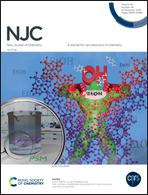Convenient multicomponent synthesis of furo[3,2-c]coumarins in the promoting medium DIPEAc and assessment of their therapeutic potential through in silico pharmacophore based target screening†
Abstract
A convergent, robust one-pot three-component approach for the synthesis of dihydrofuro[3,2-c]coumarins (DHFCs) was developed via the reaction of aryl/hetryl aldehydes, substituted phenacyl bromides and 4-hydroxycoumarin using N,N-diisopropyl ethyl ammonium acetate (DIPEAc) as the promoting medium. By virtue of its operational simplicity, efficiency, and wide substrate scope, the herein documented methodology constitutes a very attractive protocol addressing access to diversely substituted fused coumarin derivatives in a cost- and time-effective manner. Moreover, in silico pharmacophore modelling divulges the selective binding of the synthesized DHFC derivatives at the highly conserved active site catalytic cleft of Trichomonas vaginalis purine nucleoside phosphorylase (TvPNP), the indispensable enzyme of the protozoan purine salvage pathway and the potent anti-trichomoniasis drug target. The strong ligand binding is corroborated by excellent free energy of binding (ΔGbinding) profiles and further confirmed by all-atomistic molecular dynamics simulation analysis and deep learning based binding affinity (pKd) predictions. The docked conformations of DHFC derivatives at the active site catalytic cleft of TvPNP are structurally reminiscent of previously reported co-crystallized conformation of FormycinA (PDB ID: 1Z36), albeit the DHFC derivatives demonstrated stronger binding propensities. Detailed quantitative structure–function analysis, presented herein, may elucidate the potential role of the synthesized DHFC derivatives as future anti-trichomoniasis therapeutic leads.
![Graphical abstract: Convenient multicomponent synthesis of furo[3,2-c]coumarins in the promoting medium DIPEAc and assessment of their therapeutic potential through in silico pharmacophore based target screening](/en/Image/Get?imageInfo.ImageType=GA&imageInfo.ImageIdentifier.ManuscriptID=D2NJ03838B&imageInfo.ImageIdentifier.Year=2022)


 Please wait while we load your content...
Please wait while we load your content...